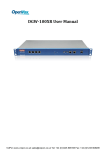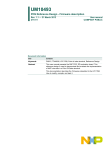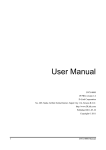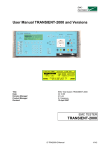Download DGW-100XR User Manual
Transcript
DGW-100XR User Manual Address: 10/F, Building 6-A, Baoneng Science and Technology Industrial Park, Longhua New District, Shenzhen, Guangdong, China, 518048 Tel: +86-755-82535461, 82535095, 82535362 Fax: +86-755-83823074 Business Contact: [email protected] Technical Support: [email protected] Business Hours: 09:00-18:00(GMT+8) from Monday to Friday URL: www.openvox.cn DGW-100XR User Manual Version1.1 (2015-8-20) Full text The overall layout adjustment OpenVox Communication Co.Ltd DGW-100XR User Manual Copyright Copyright© 2013 OpenVox Inc. All rights reserved. No part of this document may be reproduced without prior written permission. Confidentiality Information contained herein is of a highly sensitive nature and is confidential and proprietary to OpenVox Inc. No part may be distributed, reproduced or disclosed orally or in written form to any party other than the direct recipients without the express written consent of OpenVox Inc. Disclaimer OpenVox Inc. reserves the right to modify the design, characteristics, and products at any time without notification or obligation and shall not be held liable for any error or damage of any kind resulting from the use of this document. OpenVox has made every effort to ensure that the information contained in this document is accurate and complete; however, the contents of this document are subject to revision without notice. Please contact OpenVox to ensure you have the latest version of this document. Trademarks All other trademarks mentioned in this document are the property of their respective owners. OpenVox Communication Co.Ltd 1 DGW-100XR User Manual Table of Contents 1.Overview................................................................................................................................. 5 What is DGW-100XR? 5 Sample Application 5 Product Appearance 5 Main Features 7 Physical Information 7 Software 8 2. System ................................................................................................................................... 9 Status 9 Time 10 Login Settings 11 General 12 Language Settings 12 Scheduled Reboot 12 Tools and Information 13 Reboot Tools 13 Update Firmware 13 Upload and Backup Configuration 14 Restore Configuration 14 Information 14 3. T1/E1 ................................................................................................................................... 16 General 16 ISDN-PRI 17 Advanced: Interface Type 17 ISDN: Signaling 18 SS7 20 Link Set Settings 20 Link Settings 21 SS7 Config. File Backup and Restore 22 OpenVox Communication Co.Ltd 2 DGW-100XR User Manual MFC/R2 Advanced: Interface Type 22 22 MFC/R2: Signaling 23 4.VOIP ...................................................................................................................................... 25 VOIP Endpoints 25 SIP Endpoints 25 Main Endpoint Settings 25 Advanced: Registration Options 28 Call Settings 28 Advanced Timer Settings 28 Advanced: Signaling Settings 29 IAX2 Endpoint 30 Advanced SIP Settings 33 Networking 33 Advanced: NAT Settings 34 Advanced: RTP Settings 35 Parsing and Compatibility 35 Security 36 Media 37 Codec Settings 37 Advanced IAX2 Settings 38 Advanced Fax Settings 40 5. Routing ................................................................................................................................ 42 Call Routing Rule 42 Groups 45 6. Network ............................................................................................................................... 47 WAN/LAN Settings 47 DDNS Settings 48 Toolkit 49 7. Advanced ............................................................................................................................. 50 Asterisk API 50 Asterisk CLI 51 Asterisk File Editor 52 OpenVox Communication Co.Ltd 3 DGW-100XR User Manual 8. Logs...................................................................................................................................... 54 System 57 Statistics 58 OpenVox Communication Co.Ltd 4 DGW-100XR User Manual 1. Overview What is DGW-100XR? OpenVox T1/E1 Gateway is an open source asterisk-based VoIP Gateway solution for operators and call centers. It is a converged media gateway product. This kind of gateway connects traditional telephone system to IP networks and integrates VoIP PBX with the PSTN seamlessly. With friendly GUI, users may easily setup their customized Gateway. Also secondary development can be completed through AMI (Asterisk Management Interface). The DGW-100XR could support two power supply and DGW-100X series gateway support one power supply. It is developed with a wide selection of codecs and signaling protocol, including G.711A, G.711U, G.729, G.722, G.723 and GSM. It supports PRI/SS7/R2 protocol. OpenVox T1/E1 Gateway has good processing ability and stability and we provides 1/2/4 T1/E1 interface for your choice. The T1/E1 gateway will be 100% compatible with Asterisk, Elastix, trixbox, 3CX, FreeSWITCH SIP server and VOS VoIP operating platform. Sample Application Figure 1-2-1Topological Graph Product Appearance The picture below is appearance of DGW-1004. OpenVox Communication Co.Ltd 5 DGW-100XR User Manual Figure 1-3-1 Product Appearance Figure 1-3-2 Front Panel Table 1-3-1 Description of Front Panel Interface Function Color 1 Port 1-Port4 E1/T1 ports. The port numbers are different on different models, from 1 to 4. 2 Reset Reset button is used to restore the device. 3 RUN Register indicator Green 4 PWR Power Status indicator Green 5 VGA VGA monitor connector Work Status Slow blinking(Green 2s and Flash 0.1s):Work normally Fast blinking(Green 0.5s and Flash 0.5s): Work abnormally Fast blinking(Green 0.5s and Flash 0.5s): Work abnormally No blinking: Dahdi Error On: Power is on Off: Power is off OpenVox Communication Co.Ltd 6 DGW-100XR User Manual 6 Eth1 Network interface 7 Eth0 Network interface 8 USB USB interface Figure 1-3-3 Backup Panel The OpenVox DGW-100X series gateways provides one or two power supply, one power named DGW-100X ,the other is named DGW-100XR, ‘R’ stands for Reduntant. Main Features Based on Asterisk○R Editable Asterisk○R configuration file Wide selection of codecs and signaling protocol Support unlimited routing rules and flexible routing settings Stable performance, flexible dialing, friendly GUI Codecs support: G.711A, G.711U, G.729, G.723, G.722,GSM Support ports group management Echo Cancellation Connect legacy PBX systems to low-cost VoIP services Connect legacy PBX systems to remote sites over private VoIP links Connect IP PBX systems to legacy TDM services Physical Information Table 1-5-1 Description of Physical Information Weight 4301g(VS-GW1600-20G) Size 44cm*30cm*4.5cm Temperature -20~70°C (Storage) 0~40°C (Operation) OpenVox Communication Co.Ltd 7 DGW-100XR User Manual Operation humidity 10%~90% non-condensing Max power 46W LAN port 1 WAN port 1 Software Default IP: 172.16.100.1 Username: admin Password: admin Notice: Log in Figure 1-6-1 LOG IN Interface OpenVox Communication Co.Ltd 8 DGW-100XR User Manual 2. System Status On the “Status” page, you will find all Interface, Channels, SIP, IAX2,Routing,Network information and status. Figure 2-1-1 System Status Table 2-1-1 Description of System Status Options Definition OpenVox Communication Co.Ltd 9 DGW-100XR User Manual Interface Status Show the status of port, include "OK" and ”Down”. "Down" means no trunk line connected; "OK" means the trunk line of port is available. Channels Status Show the Channels status of port, include "Idle". "Busy". "Disable" and “S channel”. "Idle" means it is available; "Busy" means the channel is busy; "Disable" means it is unavailable; “S channel” means signaling channel. Time Table 2-2-1Description of Time Settings Options Definition System Time Your gateway system time. Time Zone The world time zone. Please select the one which is the same or the closest as your city. POSIX TZ String Posix timezone strings. NTP Server 1 Time server domain or hostname. For example, [time.asia.apple.com]. NTP Server 2 The first reserved NTP server. For example, [time.windows.com]. NTP Server 3 The second reserved NTP server. For example, [time.nist.gov]. Auto-Sync from NTP Whether enable automatically synchronize from NTP server or not. ON is enable, OFF is disable this function. Sync from NTP Sync time from NTP server. Sync from Client Sync time from local machine. For example, you can configure like this: Figure 2-2-1 Time Settings OpenVox Communication Co.Ltd 10 DGW-100XR User Manual You can set your gateway time Sync from NTP or Sync from Client by pressing different buttons. Login Settings Your gateway doesn't have administration role. All you can do here is to reset what new username and password to manage your gateway. And it has all privileges to operate your gateway. You can modify “Web Login Settings” and “SSH Login Settings”. If you have changed these settings, you don’t need to log out, just rewriting your new user name and password will be OK. Also you can specify the web server port number. Table 2-3-1Description of Login Settings Options User Name Password Definition Your gateway dose not have administration role. All you can do here is defining the user name and password to manage your gateway. And it has all privileges to operate your gateway .User Name :Allowed characters “-_+<>&0-9a-zA-Z”.Length:1-32 characters. Allowed characters "-_+. <>&0-9a-zA-Z". Length: 4-32 characters. Confirm Password Please input the same password as 'Password' above. Port Specify the web server port number. Figure 2-3-1 Login Settings OpenVox Communication Co.Ltd 11 DGW-100XR User Manual Notice: Whenever you do some changes, do not forget to save your configuration. General Language Settings You can choose different languages for your system. If you want to change language, you can switch “Advanced” on, then “Download” your current language package. After that, you can modify the package with the language you need. Then upload your modified packages, “Choose File” and “Add”. Figure 2-4-1 Language Settings Scheduled Reboot If switch it on, you can manage your gateway to reboot automatically as you like. There are four reboot types for you to choose, “By Day, By Week, By Month and By Running Time”. Figure 2-4-2 Reboot Types OpenVox Communication Co.Ltd 12 DGW-100XR User Manual If use your system frequently, you can set this enable, it can helps system work more efficient. Tools and Information On the “Tools” pages, there are reboot Tools, update Firmware, upload Configuration, backup Configuration and Restore Configuration toolkits. Reboot Tools You can choose system reboot and Asterisk reboot separately. Figure 2-5-1 Reboot Prompt If you press “OK”, your system will reboot and all current calls will be dropped. Asterisk Reboot is the same. Table 2-5-1 Instruction of reboots Options Definition System Reboot This will turn off your gateway and then turn it back on. This will drop all current calls. Asterisk Reboot This will restart Asterisk and drop all current calls. Update Firmware We offer 2 kinds of update types for you, you can choose System Update or System Online Update. System Online Update is an easier way to update your system, if you choose that, you will see OpenVox Communication Co.Ltd 13 DGW-100XR User Manual some information below. Figure 2-5-2Prompt Information Upload and Backup Configuration If you want to update your system and remain your previous configuration, you can first backup configuration, then you can upload configuration directly. That will be very convenient for you. Figure 2-5-3 Upload and Backup Restore Configuration Sometimes there is something wrong with your gateway that you don’t know how to solve it, mostly you will select factory reset. Then you just need to press a button, your gateway will be reset to the factory status. Figure 2-5-4 Factory Reset Information On the “Information” page, there shows some basic information about the T1/E1 gateway. You can see software and hardware version, storage usage, memory usage and some help information. OpenVox Communication Co.Ltd 14 DGW-100XR User Manual Figure 2-5-5 System Information OpenVox Communication Co.Ltd 15 DGW-100XR User Manual 3. T1/E1 General Figure 3-1-1 General Settings Table 3-1-1 Definition of General Settings Local Your local. This will be used for the tone style. Used when in-call indications need to be generated such as ring back, busy, congestion, and other call-oriented inband tone signals. Interface Type It shows you the current type of port. It has two type:E1 and T1 Figure 3-1-2 Port Details Table 3-1-3 Definition of Port Details OpenVox Communication Co.Ltd 16 DGW-100XR User Manual Options Timing Source Definition Timing Source indicate the ports as to which should be used to recover the clock.(0 for master mode, upper for client mode, small number have higher priority ) Interface Framing Coding Line Build-out Choose a line type for this interface, all ports must be the same type. Framing method for this interface Coding method for this interface Line build-out represents the length of the cable form the port on this gateway to the next device. Enable cyclic redundancy checking for error checking on line. CRC-4 support is required for all network switches in Europe, but many older switches and PBXs don’t support it. It shows you what signaling the port uses. Only used for PRI An optional description of this interface to be used for reference only. CRC4 Signaling Switch Type Description ISDN-PRI Advanced: Interface Type Figure 3-2-1 Advanced: Interface Type Table 3-2-1Definition of Interface Type Options Definition Echo Cancellation Whether or not to enable echo cancellation on this line RX Gain Whole number -24 to 24 and multiple of 3 TX Gain Whole number -24 to 24 and multiple of 3 Gain for the rx (receive -into Asterisk)channel.Default:0.0 Gain for the tx(transmit -out of Asterisk Asterisk)channel.Default:0.0 OpenVox Communication Co.Ltd 17 DGW-100XR User Manual ISDN: Signaling Figure 3-2-2 ISDN: Signaling Options Q.SIG Channel Mapping Enable Caller ID PRI Dial Plan for Dialed Number PRI Dial Plan for Dialing Number Table 3-2-2 Definition of Signaling Definition Sets logical or physical channel mapping. In logical channel mapping, channels are mapped to 1-30.In physical channel mapping, channels are mapped to 1-15,17-31,skipping the number used for the data channel, Default is physical. Whether or not to use caller ID PRI Dialplan: The ISDN-levei Type of Number (TON) or numbering plan, used for the dialed number. Leaving this as ‘unknown’ (the default) works for most cases. In some very unusual circumstances, you may need to set this to; ’dynamic’ or ‘redundant’ PRI Local Dialplan: Only RARELY used for PRI(sets the calling number’s numbering plan).In North America, the typical use is sending the 10 OpenVox Communication Co.Ltd 18 DGW-100XR User Manual Network Specific Facility (NSF) Messages Idle Bearer Reset Idle Bearer Reset Period Display Send Display Receive Overlap Dialing Allow Progress When Call Released Out-of-Band Indications Facility-based ISDN digit; caller ID number and setting the prilocaldialplan to ‘national’ (the default).Only VERY rarely will you need to change this. Some switches (AT&T especially) require network specific facility IE. Supported values are currently ‘none’,’sdn’,’ megacom’,’ tollfreemgacom’, ’ account’ Whether or not to reset unused B channels Sets the time in seconds between restart of unused B channels; defaults to ‘never’ Send/receive ISDN display IE options, the display options are a comma separated list of the following options: Block: Do not pass display text data. Name_ initial: Use display text in SETUP/CONNECT messages as the party name. Name_ update: Use display text in other messages (NOTIFY/FACILITY)for COLP name update. Name: Combined name_ initial and name_ update options. Text: Pas any unused display text data as an arbitrary display message during a call. Sent text goes out in default to ‘name’ Send/receive ISDN display IE options. The display options are a comma separated list of the following options: Block: Do not pass display text data. Name_ initial: Use display text in SETUP/CONNECT messages as the party name. Name_ update: Use display text in other messages (NOTIFY/FACILITY) for COLP name update. Name: Combined name_ initial and name_ update options. Text: Pas any unused display text data as an arbitrary display message during a call. Sent text goes out in default to ‘name’ Enable overlap dialing mode--sending overlap digits. Allow inband audio (progress) when a call is DISCONNECT Ted by the end of a PRI PRI Out of band indications. Enable this to report Busy and congestion on a PRI using out_ of_ band notification. Inband indication, as used by the gateway doesn’t seem to work with all telcos. To enable transmission of facility-based ISDN supplementary services OpenVox Communication Co.Ltd 19 DGW-100XR User Manual Supplementary Services Exclusive Channel Selection Ignore Remote Hold Indications Block Outbound Caller ID Name Wait for Caller ID Name (such as caller name form CPE over facility), enable this option. Cannot be changed on a reload. If you need to override the existing channels selection routine and force all PRI channels to be marked as exclusively selected, set this to yes. priexclusive cannot be changed on a reload. If you wish to ignore remote hold indications (and use MOH that is supplied over the B channel) enable this option. Enable if you need to hide just the name and the number for legacy PBX use. Only applies to PRI channels. Support caller ID on call waiting SS7 Link Set Settings Figure 3-3-1 Link Set Settings You can click button as shown below, when there are several link set, only one can be set to the default. OpenVox Communication Co.Ltd 20 DGW-100XR User Manual Figure 3-3-2 SS7 Link Set Settings Table 3-3-1 Definition of SS7 Link Set Settings options Name Enabled Enabled_ st Use Connect Hunting Policy Subservice t35 variant OPC DPC Set to Default Definition The linkset’s name The linkset is enable or disable The end_of_pulsing (ST) is not used to determine when incoming address is complete Reply incoming call with CON rather than ACM and ANM The CIC hunting policy (even_mu, odd_lru, seq_lth, seq_htl) is even CIC numbers, most recently used The subservice field: national (8), international l(0), auto or decimal/hex value; The auto means that the subservice is obtained from first received SLTM. The value and action for t35. Value is in msec, action is either st or timeout; if you use overlapped dialing dial plan, you might choose:t35=>4000,st Running under SS7 standard The point code for this SS7 signaling point The destination point (peer) code Set the linkset as the default linke set Link Settings OpenVox Communication Co.Ltd 21 DGW-100XR User Manual Figure 3-3-3 Link Settings You can click button as shown below. Figure 3-3-4 SS7 Link Settings SS7 Config. File Backup and Restore Figure 3-3-5 Config. File Backup and Restore MFC/R2 Advanced: Interface Type Figure 3-4-1 Advanced: Interface Type OpenVox Communication Co.Ltd 22 DGW-100XR User Manual Table 3-4-1 Definition of Interface Type options Echo Cancellation RX Gain Whole number -24 to 24 and multiple of 3 TX Gain Whole number -24 to 24 and multiple of 3 Definition Whether or not enable echo cancellation on this line Gain for the rx (receive_ into Asterisk) channel. Default:0.0 Gain for the tx (receive_ into Asterisk) channel. Default:0.0 MFC/R2: Signaling Figure 3-4-2 MFC/R2: Signaling Table 3-4-2Definition of MFC/R2: Signaling options Enable Caller ID mfcr2_init_cas_bit mfcr2_get_ani_first mfcr2_max_ani mfcr2_max_dnis mfcr2_category Definition Whether or not to use caller ID The initial position of the CAS bits (also known as ABCD bits) Whether or not to get ANI before getting DINS; some telcos require ANI first some others do not care; if this go wrong, change this value Max amount of ANI to ask for Max amount of DNIS to ask for Usually national-subscriber works just fine; you can change this setting from the dialplan ; by setting the variable MFCR2-CATEGORY;(remembering ti setMFCR2-CATEGORY from originating channels);MFCR2-CATEGORY will also be a variable in your context; on incoming calls set to the value received from OpenVox Communication Co.Ltd 23 DGW-100XR User Manual mfcr2_mfback_time out mfcr2_metering_pul se_timeout the far end;mfcr2-category=national-subscriber MFC/R2 value in milliseconds for the MF timeout MFC/R2 value in milliseconds for the metering pulse timeout OpenVox Communication Co.Ltd 24 DGW-100XR User Manual 4.VOIP VOIP Endpoints SIP Endpoints This page shows everything about your SIP, you can see status of each SIP. Figure 4-1-1 SIP Status Main Endpoint Settings You can click existed endpoints, you can click button to add a new SIP endpoint, and if you want to modify button. There are 3 kinds of registration types for choose. You can choose Anonymous, Endpoint registers with this gateway or This gateway registers with the endpoint. You can configure as follows: If you set up a SIP endpoint by registration “None” to a server, then you can’t register other SIP endpoints to this server. (If you add other SIP endpoints, this will cause Out-band Routes and Trunks confused.) OpenVox Communication Co.Ltd 25 DGW-100XR User Manual Figure 4-1-2 None Registration For convenience, we have designed a method that you can register your SIP endpoint to your gateway, thus your gateway just work as a server. Figure 4-1-3 Endpoint Register with Gateway Also you can choose registration by “This gateway registers with the endpoint”, it’s the same with “None”, except name and password. OpenVox Communication Co.Ltd 26 DGW-100XR User Manual Figure 4-1-4 This Gateway Register with the Endpoint Table 4-1-1 Definition of SIP Options Options Definition Name A name which is able to read by human. And it’s only used for user’s reference. Username Password User name the end point use to authenticate with the gateway Password the endpoint will use to authenticate with the gateway. Allowed characters Registration Whether this endpoint will registers with this gateway. Hostname or IP Address IP address or hostname of the endpoint or 'dynamic' if the endpoint has a dynamic IP address. This will require registration. Notice: if the input here is hostname and your DNS has changed, you must reboot asterisk. Transport NAT Traversal This sets the possible transport types for outgoing. Order of usage, when the respective transport protocols are enabled, is UDP, TCP, TLS. The first enabled transport type is only used for outbound messages until a Registration takes place. During the peer Registration the transport type may change to another supported type if the peer requests so. Addresses NAT-related issues in incoming SIP or media sessions. OpenVox Communication Co.Ltd 27 DGW-100XR User Manual Advanced: Registration Options Table 4-1-2 Definition of Registration Options Options Authentication User Register Extension Definition A username to use only for registration. From User When Gateway registers as a SIP user agent to a SIP proxy (provider), calls from this provider connect to this local extension. A username to identify the gateway to this endpoint. From Domain A domain to identify the gateway to this endpoint. Remote Secret A password which is only used if the gateway registers to the Port remote The portside. number the gateway will connect to at this endpoint. Qualify Whether or not to check the endpoint's connection status. Qualify frequency How often, in seconds, to check the endpoint's connection Frequency status. A proxy to which the gateway will send all outbound signaling Outbound Proxy instead of sending signaling directly to endpoints. Call Settings Table 4-1-3 Definition of Call Options Options Definition DTMF Mode Set default DTMF Mode for sending DTMF. Default: rfc2833. Other options: 'info', SIP INFO message (application/ dtmf-relay); 'Inband', Inband audio (require 64kbit codec - alaw, ulaw). Trust Remote-Party-ID Whether or not the Remote-Party-ID header should be trusted. Send Remote-Party-ID Whether or not to send the Remote-Party-ID header. Caller ID Presentation Whether or not to display Caller ID. Advanced Timer Settings OpenVox Communication Co.Ltd 28 DGW-100XR User Manual Table 4-1-4 Definition of Timer Options Options Definition Default T1 Timer Call Setup Timer This timer is used primarily in INVITE transactions. The default for Timer T1 is 500ms or the measured run-trip time between the gateway and the device if you have qualify=yes for the device. If a provisional response is not received in this amount of time, the call will auto-congest. Defaults to 64 times the default T1 timer. Session-Timers feature operates in the following three modes: originate, Request and run session-timers always; accept, run session-timers only when requested by other UA; refuse, do not run session timers in any case. Session Timers Minimum Session Minimum session refresh interval in seconds. Default is 90secs. Maximum Session Refresh Interval Maximum session refresh interval in seconds. Defaults to 1800s. Session Refresher The session refresher, uac or uas. Defaults to uas. Advanced: Signaling Settings Table 4-1-5Definition of Signaling Options Options Definition Progress Inband If we should generate in-band ringing. Always use ‘never’ to never use inband signalling, Even in cases where some buggy devices might not render it. Valid values: yes, no, never. Default: never. Append Whether or not to add;’ user=phone’ to URIs that contain a valid phone user=phone to URI number. Add Q.850 Reason Whether or not to add Reason header and to use it if it is available. Headers Honor SDP Version By default, the gateway will honor the session version number in SDP packets and will only modify the SDP session if the version number changes. Turn This option off to force the SDP session version number and treat all SDP data as new data. This is require for devices that send non-standard SDP packets (observed with Microsoft OC S).By default This option is on. Allow Transfers Whether or not to globally enable transfers. Choosing ‘no’ will disable all transfers (unless enable in peers or users). Default is enabled. Allow Whether or not to allow 302 or REDIR to non-local SIP address .Note that OpenVox Communication Co.Ltd 29 DGW-100XR User Manual Promiscuous Redirects Max Forwards Send TRYING on REGISTER promiscredir when redirects are made to the local system will cause loops since this gateway is incapable of performing a ‘hairpin’ call. Setting for the SIP Max-Forwards header (loop prevention). Send 100 Trying when the endpoint registers. Table 4-1-6 Definition of Fax Options Options Mode Enabled Error Correction Max Datagram Definition Working mode T.38 and T.30 Enabled Error Correction In some cases,T.38 endpoints will provide a T38FaxMxDatagram value (during T.38 setup) that is based on an incorrect interpretation of the T.38 recommendation, and result in failures because Asterisk does not believe it can send T.38 packets of a reasonable size to that endpoint (Cisco media gateway are one example of this situation).In these cases, during a T.38 call you will see warring messages on The console/in the logs from the Asterisk UDPTL stack complaining about lack of buffer space to send T.38FaxMaxDatagram value specified by the other end[point, and use a configured value instead. FAX detection will cause the SIP channel to jump to the ‘faX’ extension (if exists) based one or more events being detected. The events that can be detected are an incoming CNG tone or an incoming T.38 re-INVITE request. activate T38 fax gateway with ‘timeout’ seconds activate T38 fax gateway with ‘timeout’ seconds Fax Detect Fax Activity Fax Timeout IAX2 Endpoint Figure 4-1-5 IAX2 Endpoint You can click button as shown below OpenVox Communication Co.Ltd 30 DGW-100XR User Manual Figure 4-1-6 Edit IAX Endpoint "9001" Table 4-1-6 Definition of IAX2 Endpoint Options Definition Name A name which is able to read by human. And it’s only used for user’s reference. User name User name the endpoint will use to authenticate with the gateway Password Password the endpoint will use to authenticate with gateway. Allowed characters OpenVox Communication Co.Ltd 31 DGW-100XR User Manual Registration Whether this endpoint will register to this gateway or this gateway to the endpoint. Hostname or IP IP address or hostname of the endpoint or ‘dynamic’ if the endpoint has a dynamic Address IP address. This will require registration. Notice: If the input here is hostname and your DNS has changed, you must reboot asterisk. Auth Authentication method for connections Transfer Disable or not IAX2 native transfer Trunk Use IAX2 trunking with this host Qualify Whether or not to check the endpoint’s connection status. Qualify Smothing Use an average of the last two PONG result to reduce falsely detected LAGGED host. The default is ‘no’. Qualify Freq Ok How frequently to ping the peer when everything seems to be OK, in milliseconds. Qualify Freq not How frequently to ping the peer when it’s either; Ok LAGGED or UNAVAILABLE, in milliseconds. Port The port number the gateway will connect to at this endpoint. Encryption Enable IAX2 encryption. The default is no. Force Encryption Force encryption insures no connection is established unless both sides support encryption. By turning this option on, encryption is automatically; turned on as well. The default is no. Trunk Max Size Defaults to 128000 bytes, which supports up to 800; calls of ulaw at 20ms a frame. Trunk MTU With a large amount of traffic on IAX2 trunk, there is a risk of bad voice quality when allowing the Linux system to handle fragmentation of UDP packets. Depending on the side of each payload, allowing the OS to handle fragmentation may not be very efficient. This setting sets the maximum transmission unit for AIX2 UDP trunking. The default is 1240 bytes which means if a trunk’s payload is over 1240 bytes for every 20ms it will be broken into multiple 1240 bytes messages. Zero disables this functionality and let’s the OS handle fragmentation. Trunk Frequency How frequently to send trunk msgs (in ms). This is 20ms by default. Trunk Time Should we send timestamps for the individual sub_frames within trunk frames? Stamps There is a small bandwith use for these (less than 1kbps/call), but they ensure that frame timestamps get sent end-to-end properly. If both ends of all your trunks go directly to TDM, _and_your trunkfreq equals the frame length for your codecs, you OpenVox Communication Co.Ltd 32 DGW-100XR User Manual can probably suppress these. The receiver must also need to have it enabled. Min. RegExpire Minimum amounts of time that IAX2 peers can request as a registration interval (in seconds). Max. RegExpire Maximum amounts of time that IAX2 peers can request as a registration expiration interval(in seconds). Advanced SIP Settings Networking Table 4-2-1 Definition of Networking Options Options Definition UDP Bind Port Choose a port on which to listen for UDP traffic. Enable TCP Enable server for incoming TCP connection (default is no). TCP Bind Port Choose a port on which to listen for TCP traffic. The maximum number of seconds a client has to authenticate. If TCP Authentication Timeout the client does not authenticate before this timeout expires, the client will be disconnected.(default value is: 30 seconds). TCP Authentication Limit The maximum number of unauthenticated sessions that will be allowed to connect at any given time (default is: 50). Enable DNS SRV lookups on outbound calls Note: the gateway only uses the first host in SRV records Disabling DNS SRV lookups Enable Hostname Lookup disables the ability to place SIP calls based on domain names to some other SIP users on the Internet specifying a port in a SIP peer definition or when dialing outbound calls with suppress SRV Enable Internal SIP Call Internal SIP Call Prefix lookups that peer or call. SIP calls or not when you select the Whetherfor enable the internal registration option "Endpoint registers with this gateway". Specify a prefix before routing the internal calls. OpenVox Communication Co.Ltd 33 DGW-100XR User Manual Advanced: NAT Settings Table 4-2-2 Definition of NAT Settings Options Options Definition Format:192.168.0.0/255.255.0.0 or 172.16.0.0./12. A list of IP address Local Network or IP ranges which are located inside a NATed network. This gateway will replace the internal IP address in SIP and SDP messages with the external IP address when a NAT exists between the gateway and other Local Network List endpoints. Local IP address list that you added. Through the use of the test_stun_monitor module, the gateway has the ability to detect when the perceived external network address has changed. When the stun_ monitor is installed and configured, Subscribe chan_sip will renew all outbound registrations when the monitor Network Change detects any sort of network change has occurred. By default this Event option is enabled, but only takes effect once res_stun_monitor is configured. If res_stun_monitor is enabled and you wish to not generate all outbound registrations on a network change, use the option below to disable this feature. Match External Address Locally Only substitute the exeternaddr or externhost setting if it matches Dynamic Exclude Static Disallow all dynamic hosts from registering as any IP address used for staticly defined hosts .This helps avoid the configuration error of allowing your users to register at the same address as a SIP provide. Externally Mapped TCP Port The externally mapped TCP port, when the gateway is behind a static NAT or PAI External Address The external address (and optional TCP port) of the NAT. External address=hostname [:port] specifies a static address[:port] to be used in SIP and SDP messages. Examples: External address=12.34.56.78 External address=12.34.56.78.9900 OpenVox Communication Co.Ltd 34 DGW-100XR User Manual The external hostname (and optional TCP port) of the NAT. External Hostname=hostname[:port] is similar to External Hostname “External address”. Examples: External Hostname=foo.dyndns.net Hostname Refresh Interval How often to perform a hostname lookup. This can be useful when your NAT device lets you choose the port mapping, but the IP address is dynamic. Beware, you might suffer from service disruption when the name server resolution fails. Advanced: RTP Settings Table 4-2-3 Definition of RTP Settings Options Options Definition Start of RTP Port Range Start of range of port numbers to be used for RTP. End of RTP port Range End of range of port numbers to be used for RTP. Parsing and Compatibility Table 4-2-4 Instruction of Parsing and Compatibility Options Definition Strict RFC Interpretation Check header tags, character conversion in URIs, and multiline headers for strict SIP compatibility(default is yes) Send Compact Headers SDP Owner Send compact SIP headers Allows you to change the username filed in the SDP owner string. This filed MUST NOT contain spaces. OpenVox Communication Co.Ltd 35 DGW-100XR User Manual Disallowed SIP Methods When a dialog is started with another SIP endpoint, the other endpoint should include an Allow header telling us what SIP methods the endpoint implements. However, some endpoint either do not include an Allow header or lie about what methods they implement. In the former case, the gateway makes the assumption that the endpoint support all known SIP methods. If you know that your SIP endpoint does not provide support for a specific method, then you may provide a list of methods that your endpoint does not implement in the disallowed_ methods option. Note that if your endpoint is truthful with its Allow header, then there is need to set this option. Shrink Caller ID The shrinkcallerid function removes '(', ' ', ')', non-trailing '.', and '-' not in square brackets. For example, the caller id value 555.5555 becomes 5555555 when this option is enabled. Disabling this option results in no modification of the caller id value, which is necessary when the caller id represents something that must be preserved. By default this option is on. Maximum Registration Expiry Maximum allowed time of incoming registrations and subscriptions (seconds). Minimum Registration Expiry Default Registration Expiry Registration Timeout Number of Registration Minimum length of registrations/subscriptions (default 60). Default length of incoming/outgoing registration. How often, in seconds, to retry registration calls. Default 20 seconds. Number of registration attempts before we give up.0=continue forever, hammering the other server until it accepts the registration. Default is 0 tries, continue forever. Security Table 4-2-5 Instruction of Security Option Definition Match Auth Username If available, match user entry using the 'username' field from the authentication line instead of the 'from' field. OpenVox Communication Co.Ltd 36 DGW-100XR User Manual Realm Realm for digest authentication. Realms MUST be globally unique according to RFC 3261. Set this to your host name or domain name. Use Domain as Realm Use the domain from the SIP Domains setting as the realm. In this case, the realm will be based on the request 'to' or 'from' header and should match one of the domain. Otherwise, the configured 'realm' value will be used. Always Auth Reject When an incoming INVITE or REGISTER is to be rejected, for any reason, always reject with an identical response equivalent to valid username and invalid password/hash instead of letting the requester know whether there was a matching user or peer for their request. This reduces the ability of an attacker to scan for valid SIP usernames. This option is set to 'yes' by default. Authenticate Options Requests Enabling this option will authenticate OPTIONS requests just like INVITE requests are. By default this option is disabled. Allow Guest Calling Allow or reject guest calls (default is yes, to allow). If your gateway is connected to the Internet and you allow guest calls, you want to check which services you offer everyone out there, by enabling them in the default context. Media Table 4-2-6 Instruction of Media Options Definition TOS for SIP Packets Sets type of service for SIP packets TOS for RTP Packets Sets type of service for RTP packets Codec Settings Select codecs from the list below. OpenVox Communication Co.Ltd 37 DGW-100XR User Manual Figure 4-2-1 Codec Settings Advanced IAX2 Settings Table 4-3-1 Instruction of General Options Definition Bind Port Bind port and bindaddr may be specified Enable IAXCompat More than once to bind to multiple addresses, but the first will be the default. Enable Nochecksums Set iaxcompat to yes if you plan to use layered switches or some other scenario which may cause some delay when doing a lookup in the dialplan. It incurs a small performance hit to enable it. This option cause Asterisk to spawn a separate thread when it receives an IAX DPREQ (Dialplan Request) instead of blocking while it waits for a response. Enable Delay Reject Disable UDP checksums (if no checksums is set, then no checksums will be ADSI ADSI (Analog Display Services Interface) can be enable if you have (or may calculated/checked on system supporting the feature) have) ADSI compatible CPE equipment. SRV Loopup Whether or not to perform an SRV lookup on outbound calls AMA Flags You may specify a global default AMA flag for iaxtel calls. These flags are used in the generation of call detail records. autokill If we don’t get ACK to our NEW within 2000ms,and autokill is set to yes, then we cancel the whole thing(that’s enough time for one retransmission OpenVox Communication Co.Ltd 38 DGW-100XR User Manual only ).This is used to keep things from stalling for a long time for a host that is not available for bad connections. Language You may specify a global default language for users. This can be specified also on a per-user basis. If omitted, will fallback to English(en) Account Code You may specify a default account for Call Detail Records (CDRs) in addition specifying on a per-user basis. Table 4-3-2 Instruction of Music on Hold Options Mohsuggest Mohinterpret Definition The ‘Mohsuggest’ option specifies which music on hold class to suggest to the peer channel when this channel place the peer on hold. It may be specified globally or on a per-user or per-peer basis. You may specify a global default language for users. This can be specified also on a per-user basis. If omitted, will fallback to English(en) Table 4-3-3 Instruction of Codec Settings Options Band Width Disallow Allow Codec Priority Definition Specify bandwith of low, medium, or high to control which codes are used in general Fine tune codes here using “allow” and “disallow” clause with specific codes Fine tune codes here using “allow” and “disallow” clause with specific codes Codec priority controls the codec negotiation of an inbound IAX2 call. This option is inherited to all user entity separately which will override the setting in general. Table 4-3-4 Instruction of Jitter Buffer Options Jitter Buffer Force Jitter Buffer Max Jitter Buffers Resyncthreshold Definition Global default as to whether you want the jitter buffer at all In the ideal world, when we bridge VoIP channels we don’t want to jitter buffering on the switch, since the endpoints can each handle this. However, some endpoints may have poor jitter buffers themselves, so this option will force to always jitter buffer, even in this case. A maximum size for the jitter buffer When the jitter buffer notice a significant change in delay that continue over a few frames, it will resync, assuming that the change in delay was caused by a timestamping mix-up. The threshold for noticing a change in delay is measured as twice the measured jitter plus this resync threshold. OpenVox Communication Co.Ltd 39 DGW-100XR User Manual Max Jitter Interps Jitter Target Extra The maximum number of interpolation frames the jitter buffer should return in a row. Since some clients do not send CNG/DTX frames to indicate silence, the jitter buffer will assume silence has begun after returning this many interpolations. This prevents interpolating throughout a long silence. Number of milliseconds by which the new jitter buffer will pad its size. The default is 40, so without modification, the new jitter buffer will set its size to the jitter value may help if your network normally has low jitter, but occasionally has spikes. Table 4-3-5 Instruction of Misc Settings Options IAX Thread Count IAX Max Thread Count Definition Establishes the number of iax helper thread to handle I/O Establishes the number of extra dynamic threads that may by spawned to handle I/O Max Call Number The ‘maxcallnumbers’ option limits the amount of call numbers allowed for each individual remote IP address. Once an IP address reaches its call number limit, no more new connections are allowed until the previous ones close. This option can be used in a peer definition as well, but only takes effect for the IP of a dynamic peer after it completes registration. MaxCallNumbers_Nonvalidated The ‘maxcallnumbers-nonvalidated’ is used to set the combined number of call numbers that can be allocated for connections where call token validation has been disabled. Unlike the ‘maxcallnumbers’ option, this limit is not separate for each individual IP address. Any connection resulting in a non-call token validated call number being allocated contributes to this limit. For use cases, see the call should be sufficient in most cases. Table 4-3-6 Instruction of Quality of Service Options Tos Cos Definition Type of service Class of service Advanced Fax Settings Table 4-4-1 Instruction of Quality of Fax Settings Options Definition OpenVox Communication Co.Ltd 40 DGW-100XR User Manual Udptl Start Udptl End Udptl Checksums Udptl Fec Entries Udptl Fec Span Use Even Ports Maximum Transmission Rate Minimum Transmission Rate Send Progress/Status events to manager session Modem Capabilities ECM DPTL start configure addresses DPTL end configure addresses Whether to enable or disable UDP checksums on UDPTL traffic The number of error correction entries in a UDPTL packet The span over which parity is calculated for FEC in a UDPTL packet Some VoIP providers will only accept an offer with an even-numbered UDPTL port. Set this option so that Asterisk will only attempt to use even-numbered ports when negotiating T.38. Default is no. Maximum Transmission Rate Minimum Transmission Rate Manager events with ‘call’ class permissions will receive events indicating the steps to initiate a fax session. Fax completion events are always sent to manager sessions with ‘call’ class permissions, regardless of the value of this option. Set this value to modify the default modem options. Defasult:v17,v27,v29 Enable/disable T.30 ECM(error correction mode) by default OpenVox Communication Co.Ltd 41 DGW-100XR User Manual 5. Routing Figure 5-1-1 Routing Rules You are allowed to set up new routing rule by , and after setting routing rules, move rules’ order by pulling up and down, click delete it. Finally click the button to edit the routing and button to save what you set. to shows current routing rules. Otherwise you can set up unlimited routing rules. Call Routing Rule There is an example for Routing rules number conversion, it transform calling, called number at the same time. Suppose you want eleven numbers start at 159 to call the eleven numbers of start at 136. Calling transform delete the three numbers from left, then writing number 086 as prefix, delete the last four numbers, and then add number 0755 at the end, it will show caller name is openvox. Called transform adds 086 as prefix , and Change the last two number to 88. Figure 5-1-2 processing prepend prefix rules Calling Transf ormation Match SdfR StA pattern 086 159 ××× RdfR Caller Name 4 0755 OpenVox 2 88 N/A ××× ×× Called 086 transformation 136 ××× ××× ×× You can click button to set up your routings. OpenVox Communication Co.Ltd 42 DGW-100XR User Manual Figure 5-1-3 Example of Set Up Routing Rule The figure above realizes that calls from “support” SIP endpoint switch you have registered will be transferred to Port-1. When “Call Comes in From” is 1001, “prepend”, “prefix” and “match pattern” in “Advanced Routing Rule” are ineffective, and just “CallerID” option is available. Table 5-1-1 Definition of Routing Options Options Definition Routing Name The name of this route. Should be used to describe what types of calls this route matches (for example, 'SIP2Ports' or 'Ports2SIP'). Call Comes in From The launching point of incoming calls. Send call Through The destination to receive the incoming calls. Table 5-1-2 Description of Advanced Routing Rule Options Definition OpenVox Communication Co.Ltd 43 DGW-100XR User Manual Dial Patterns that will use this Route A Dial Pattern is a unique set of digits that will select this route and send the call to the designated trunks. If a dialed pattern matches this route, no subsequent routes will be tried. If Time Groups are enabled, subsequent routes will be checked for matches outside of the designated time(s). Rules: X matches any digit from 0-9 Z matches any digit from 1-9 N matches any digit from 2-9 [1237-9] matches any digit in the brackets (example: 1,2,3,7,8,9) wildcard: matches one or more dialed digits. prepend: Digits to prepend to a successful match. If the dialed number matches the patterns specified by the subsequent columns, then this will be prepended before sending to the trunks. prefix: Prefix to remove on a successful match. The dialed number is compared to this and the subsequent columns for a match. Upon a match, this prefix is removed from the dialed number before sending it to the trunks. match pattern: The dialed number will be compared against the prefix + this match pattern. Upon a match, the match pattern portion of the dialed number will be sent to the trunks SDfR(Stripped Digits from Right): The amount of digits to be deleted from the right end of the number. If the value of this item exceeds the length of the current number, the whole number will be deleted. RDfR( Reserved Digits from Right) :Designated information to be added to the right end of the current number. StA(Suffix to Add):Designated information to be added to the right end of the current number. Caller Name: What caller name would you like to set before sending this call to the endpoint. Native language charset is allowable, e.g. Chinese charset, Latin charset. Forward Number What destination number will you dial? This is very useful when you have a transfer call. Failover Call Through Number The gateway will attempt to send the call out each of these in the order you specify. You can create various time routes and use these time conditions to limit some specific calls. OpenVox Communication Co.Ltd 44 DGW-100XR User Manual Figure 5-1-4Time Patterns that will use this Route If you configure like this, then from January to March, from the first day to the last day of these months, from Monday to Thursday, from 00:00 to 02:00, during this time (meet all above time conditions), all calls will follow this route. And the time will synchronize with your Sever time. Figure 5-1-5Change Rules You can set your caller ID name and caller number as you like before sending the call to the endpoint. You can also configure forward number when you have a transfer call. Figure 5-1-6 Failover Call Through Number You can add one or more “Failover Call Through Numbers”. Groups Sometimes you want to make a call through one port, but you don’t know if it is available, so you have to check which port is free. That would be troublesome. But with our product, you don’t need to worry about it. You can combine many Ports or SIP to groups. Then if you want to make a call, it will find available port automatically. OpenVox Communication Co.Ltd 45 DGW-100XR User Manual Figure 5-2-1 Establish Group OpenVox Communication Co.Ltd 46 DGW-100XR User Manual 6. Network On “Network” page, there are three sub-pages, “WAN Settings”, “DDNS Settings”, and “Toolkit”. WAN/LAN Settings There are two types of WAN port IP, Static and DHCP. Static is the default type, and it is 172.16.100.1. The LAN port is a fixed IP and it is 192.168.100.1. Figure 6-1-1 WAN/LAN Settings Interface Table 6-1-1Definition of WAN/LAN Settings Options Definition Interface The name of network interface. Type The method to get IP. Static: manually set up your gateway IP. DHCP: automatically get IP from your local LAN. MAC Physical address of your network interface. Address The IP address of your gateway. Network The subnet mask of your gateway. Default Gateway Default getaway IP address. Basically this info is from your local network service provider, and you can fill in four DNS servers. Figure 6-1-2 DNS Interface OpenVox Communication Co.Ltd 47 DGW-100XR User Manual DNS Servers: A list of DNS IP address. Basically this info is from your local network service provider. DDNS Settings You can enable or disable DDNS (dynamic domain name server). Figure 6-2-1 DDNS Interface Table 6-2-1 Definition of DDNS Settings Options Definition DDNS Enable/Disable DDNS(dynamic domain name server) Type Set the type of DDNS server. Username Your DDNS account’s login name. Password Your DDNS account’s password. Your domain The domain to which your web server will belong. OpenVox Communication Co.Ltd 48 DGW-100XR User Manual Toolkit It is used to check network connectivity. Support Ping command on web GUI. Figure 6-3-1 Network Connectivity Checking OpenVox Communication Co.Ltd 49 DGW-100XR User Manual 7. Advanced Asterisk API When you make “Enable” switch to “ON”, this page is available. Figure 7-1-1 API Interface Table 7-1-1 Definition of Asterisk API Options Definition Port Network port number Manager Name Name of the manager without space Manager secret Password for the manager. Characters: Allowed characters Length:4-32 characters. Deny If you want to deny many hosts or networks, use char & as separator. Example: 0.0.0.0/0.0.0.0 or 192.168.1.0/255.255.255.0&10.0.0.0/255.0.0.0 Permit If you want to permit many hosts or network, use char & as separator. Example: 0.0.0.0/0.0.0.0 or 192.168.1.0/255.255.255.0&10.0.0.0/255.0.0.0 System General information about the system and ability to run system management commands, such as Shutdown, Restart, and Reload. “-_+.<>&0-9a-zA-Z”. OpenVox Communication Co.Ltd 50 DGW-100XR User Manual Call Information about channels and ability to set information in a running channel. Log Logging information. Read-only. (Defined but not yet used.) Verbose Verbose information. Read-only. (Defined but not yet used.) Command Permission to run CLI commands. Write-only. Agent Information about queues and agents and ability to add queue members to a queue. User Permission to send and receive UserEvent. Config Ability to read and write configuration files. DTMF Receive DTMF events. Read-only. Reporting Ability to get information about the system. Dialplan Receive NewExten and Var Set events. Read-only. Originate Permission to originate new calls. Write-only. All Select all or deselect all. Once you set like the above figure, the host 172.16.100.110/255.255.0.0 is allowed to access the gateway API. Please refer to the following figure to access the gateway API by putty. 172.16.100.110 is the gateway’s IP, and 5038 is its API port. Figure 7-1-2 Putty Access Asterisk CLI In this page, you are allowed to run Asterisk commands. Figure 7-2-1 Asterisk Command Interface OpenVox Communication Co.Ltd 51 DGW-100XR User Manual Table 7-2-1 Definition of Asterisk CLI Options Definition Command Type your Asterisk CLI commands here to check or debug your gateway. If you type “help” or “?” and execute it, the page will show you the executable commands. Asterisk File Editor On this page, you are allowed to edit and create configuration files. Click the file to edit. OpenVox Communication Co.Ltd 52 DGW-100XR User Manual Figure 7-3-1 Configuration Files List Click “New Configuration File” to create a new configuration file. After editing or creating, please reload Asterisk. OpenVox Communication Co.Ltd 53 DGW-100XR User Manual 8. Logs On the “Log Settings” page, you should set the related logs on to scan the responding logs page. For example, set “System Logs” on like the following, then you can turn to “System” page for system logs, otherwise, system logs is unavailable. And the same with other log pages. Log Settings Figure 8-1-1 Logs Settings OpenVox Communication Co.Ltd 54 DGW-100XR User Manual Figure 8-1-2 System Logs Output Table 8-1-1 Definition of Logs Options Definition Auto clean: (System Logs) switch on : when the size of log file reaches the max size, the system will cut a half of the file. New logs will be retained. switch off : logs will remain, and the file size will increase gradually. default on, default size=1MB Verbose: Asterisk console verbose message switch. Notice: Asterisk console notice message switch. Warning: Asterisk console warning message switch. Debug: Asterisk console debug message switch. Error: Asterisk console error message switch. DTMF: Asterisk console DTMF info switch. Auto clean: (asterisk logs) switch on : when the size of log file reaches the max size, the system will cut a half of the file. New logs will be retained. Switch off: logs will remain, and the file size will increase gradually. default on, default size=100KB OpenVox Communication Co.Ltd 55 DGW-100XR User Manual SIP Logs: Whether enable or disable SIP log. Auto clean: (SIP logs) switch on : when the size of log file reaches the max size, the system will cut a half of the file. New logs will be retained. Switch off: logs will remain, and the file size will increase gradually. default on, default size=2MB IAX2 Logs Whether enable or disable IAX log Auto clean switch on : when the size of log file reaches the max size, the system will cut a half of the file. New logs will be retained. Switch off: logs will remain, and the file size will increase gradually. default on, default size=2MB MFC/ R2 Logs Whether enable or disable MFC/ R2 Logs log. Auto clean switch on : when the size of log file reaches the max size, the system will cut a half of the file. New logs will be retained. Switch off: logs will remain, and the file size will increase gradually. default on, default size=100KB PRI Logs PRI port logs. You can choose one or more ports. If you choose "All", the "PRI" page will show you the logs about all the ports. Auto clean (PRI logs) switch on : when the size of log file reaches the max size, the system will cut a half of the file. New logs will be retained. Switch off: logs will remain, and the file size will increase gradually. default on, default size=2MB .SS7 Logs Whether enable or disable SS7 log Auto clean switch on : when the size of log file reaches the max size, the system will cut a half of the file. New logs will be retained. Switch off: logs will remain, and the file size will increase gradually. default on, default size=100KB OpenVox Communication Co.Ltd 56 DGW-100XR User Manual Call Statistics Whether enable or disable Call Statistics. System Figure 8-2-1 System Logs OpenVox Communication Co.Ltd 57 DGW-100XR User Manual Asterisk Figure 8-3-1 Asterisk Logs On the pages of “system”, ”Asterisk”, “SIP”, “IAX2”, “SS7”, and “MFC/R2”, there are some functions: Displays the log by port, refresh regularly and log download. Statistics Figure 8-9-1 Call Statistics The figure of call statistics, you’ll find “Answered” “congestion” “busy” “failed” “no answer” “current calls” “accumulated” “calls duration” . OpenVox Communication Co.Ltd 58






































































